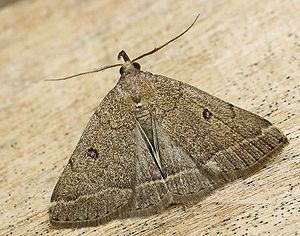Rock Corridor Tension Owl
| Rock Corridor Tension Owl | ||||||||||||
|---|---|---|---|---|---|---|---|---|---|---|---|---|

Rock Flurry Owl ( Zanclognatha zelleralis ) |
||||||||||||
| Systematics | ||||||||||||
|
||||||||||||
| Scientific name | ||||||||||||
| Zanclognatha zelleralis | ||||||||||||
| ( Wocke , 1850) |
The rock- floor tension owl ( Zanclognatha zelleralis ) is a butterfly ( moth ) from the family of the owl butterflies (Erebidae).
features
butterfly
The wingspan of the moth is 26 to 32 millimeters. The front wings are predominantly colored light brown-gray. Black-gray, strongly serrated transverse lines stand out clearly. The kidney flaw is enclosed by an almost circular black line. The relatively straight wavy line is yellow in color and continues on the gray-brown hind wings, the seam line is broken up into black spots. The palps are very elongated and bent downwards.
Caterpillar
Adult caterpillars are yellowish-gray in color and have many fine black spots. The back line is reddish in color, slightly thickened at the rear end of the segments.
Similar species
The olive borer owl ( Zanclognatha tarsipennalis ) and the rock bush forest tension owl ( Zanclognatha lunalis ) mainly differ in their crescent-shaped or sickle-shaped kidney blemishes.
Synonyms
The following synonyms are known from the literature :
- Herminia tarsicristalis Wocke , 1850
distribution and habitat
The species is widespread in Europe, especially in the Mediterranean region , on the Balkan Peninsula , in Hungary , Austria , Slovakia , the Czech Republic and Poland, as well as east to Turkey and the Crimea . Relic occurrences exist in Valais and in Germany ( southern Black Forest , Middle Rhine and Nahe regions , Thuringian slate mountains and Upper Lusatia ). In the Southern Alps it occurs up to a height of 400 meters, in the Black Forest up to a height of 760 meters. Preferred habitat are rocky meadows and heaths, light forests and bush landscapes.
Way of life
The moths of the rock-necked butterfly owl are nocturnal and fly in one generation in northern areas in June and July. Occasionally two generations appear in the south. The flight times are then from mid-May to early July and from late July to mid-September. Artificial light sources are sometimes approached in numbers. The caterpillars live from the end of July on fallen, wilted, dry or rotting leaves of deciduous trees or low plants. They hibernate.
Danger
The Felsflur-Spannereule has only been found in a few federal states in Germany. It is listed on the Red List of Threatened Species as a “species with geographical restriction”.
swell
Individual evidence
- ↑ Zanclognatha zelleralis at Fauna Europaea. Retrieved November 5, 2015
- ↑ a b Günter Ebert (Ed.): The butterflies of Baden-Württemberg. Volume 5. Moth III. Ulmer Verlag, Stuttgart 1997 ISBN 3-8001-3481-0
- ^ A b Walter Forster, Theodor A. Wohlfahrt: The butterflies of Central Europe. Volume 4: Owls. (Noctuidae). Franckh'sche Verlagshandlung, Stuttgart 1971, ISBN 3-440-03752-5 .
- ↑ Federal Agency for Nature Conservation (Ed.): Red List of Endangered Animals in Germany . Landwirtschaftsverlag, Münster 1998, ISBN 3-89624-110-9 , p. 106 .
literature
- Arno Bergmann: The large butterflies of Central Germany. Volume 4/2: Owls. Distribution, forms and communities. Urania-Verlag, Jena 1954, DNB 450378381 .
- Manfred Koch : We determine butterflies. Volume 3: Owls. 2nd, expanded edition. Neumann, Leipzig / Radebeul 1972, DNB 760072930 .
- Walter Forster , Theodor A. Wohlfahrt : The butterflies of Central Europe. Volume 4: Owls. (Noctuidae). Franckh'sche Verlagshandlung, Stuttgart 1971, ISBN 3-440-03752-5 .
- Günter Ebert (Ed.): The butterflies of Baden-Württemberg. Volume 5. Moth III. Ulmer Verlag, Stuttgart 1997 ISBN 3-8001-3481-0
Web links
- Lepiforum e. V. - Taxonomy and photos
- schmetterlinge-deutschlands.de - endangerment